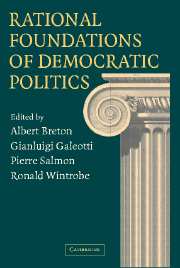Book contents
- Frontmatter
- Contents
- List of Contributors
- 1 Introduction
- PART ONE SOME PROBLEMS WITH DEMOCRATIC INSTITUTIONS AND TRENDS IN THEIR EVOLUTION
- PART TWO MORALS IN POLITICS
- PART THREE SOCIAL CAPITAL
- PART FOUR THE ROLE OF CONSTITUTIONS
- 10 Voting Rules: A Constitutional Quandary
- 11 Citizens' Sovereignty, Constitutional Commitments, and Renegotiation: Original versus Continuing Agreement
- 12 Constitutional Rules and Competitive Politics: Their Effects on Secessionism
- Index
- References
12 - Constitutional Rules and Competitive Politics: Their Effects on Secessionism
Published online by Cambridge University Press: 28 July 2009
- Frontmatter
- Contents
- List of Contributors
- 1 Introduction
- PART ONE SOME PROBLEMS WITH DEMOCRATIC INSTITUTIONS AND TRENDS IN THEIR EVOLUTION
- PART TWO MORALS IN POLITICS
- PART THREE SOCIAL CAPITAL
- PART FOUR THE ROLE OF CONSTITUTIONS
- 10 Voting Rules: A Constitutional Quandary
- 11 Citizens' Sovereignty, Constitutional Commitments, and Renegotiation: Original versus Continuing Agreement
- 12 Constitutional Rules and Competitive Politics: Their Effects on Secessionism
- Index
- References
Summary
INTRODUCTION
Constitutional rules (or, more generally, constitutional variables) must be analyzed in competitive settings. These rules can constrain the behavior of public sector actors and ensure that political competition remains active and vigorous. Political competition, in turn, can affect the capacity of constitutions to constrain political action. Among the different ways of modeling political competition in the case of democratic societies, we retain two: a) electoral competition, as understood in the probabilistic voting model; and b) competition among centers of power in compound governments (Breton, 1996).
In that framework, the preferences and opinions of citizens in their capacity as voters or demanders of public policies necessarily count. In the literature, these preferences are usually restricted to goods and services; in what follows, they are defined over constitutional variables as well. Moreover, we assume that there will necessarily be trade-offs or compensations between goods and services on the one hand and constitutional variables on the other. This is often the case at the level of individual citizens, but it will obtain at the collective level as a matter of necessity. By itself, this creates a first strong linkage among all issues, including the constitutional ones. In addition, a second linkage derives from the fact that decision-makers in the public sector normally function in institutional settings – parliaments, cabinets, political parties, for instance – that make it natural and easy to bring together apparently unconnected issues.
- Type
- Chapter
- Information
- Rational Foundations of Democratic Politics , pp. 222 - 246Publisher: Cambridge University PressPrint publication year: 2003



